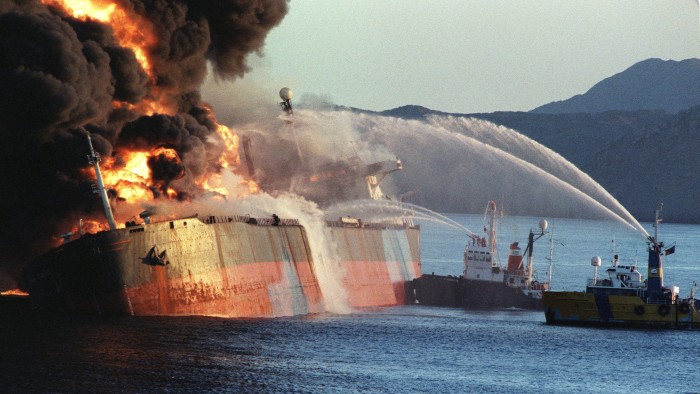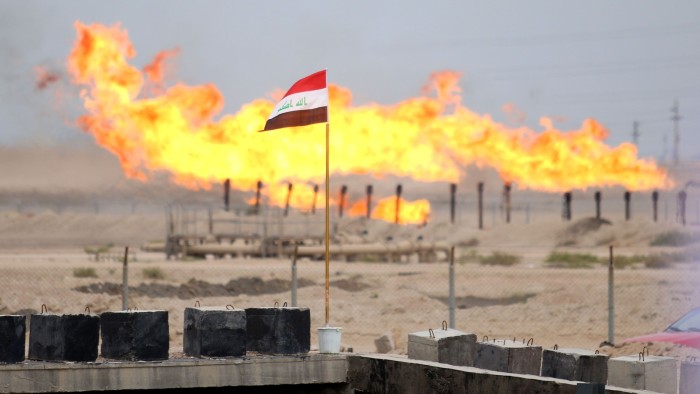Mines across one of the world’s most strategically important waterways. Western-made missiles scuttling oil tankers that braved the journey. The US on the brink of a direct war with Iran.
So went the “tanker war” of the 1980s, when Iranian and Iraqi sieges of the 33km-wide Strait of Hormuz — one of the most vulnerable parts of the global economy — turned oil shipments into floating targets.
As the world braces for Iran’s potential retaliation to US air strikes, many fear escalation could lead to Tehran once again targeting the strait, a chokepoint through which a quarter of the world’s seaborne oil trade and a fifth of its natural gas exports passes.
In the confrontations of the 1980s, during which Washington put Kuwaiti tankers under US flags and dispatched 35 naval escorts, both Iran and Iraq used sea mines, naval vessels and anti-ship missiles — French-made Exocets and Chinese made Silkworms — to try to close off the strait to their rival’s tankers. It pushed the US and Iran perilously close to open conflict, one that presaged the present day.
Several Iranian members of parliament on Sunday called for closing the Hormuz strait in retaliation for the US air strikes, though a decision on the matter would be taken only by the country’s Supreme National Security Council. One regime insider said no radical decisions — including closing the strait — were currently on the table.
However, in the event of a protracted conflict with the US, analysts say that Iran’s naval forces, which have largely escaped damage in recent Israeli and US air strikes, could threaten a repeat of the “tanker war”: closing the strait to shipping using relatively simple weaponry.
These range from mines that sit on the seabed — as used by Iraq in the 1991 Gulf war to block amphibious landings and harass US naval operations — to the limpet mines containing a few pounds of explosive magnetically attached to a ship’s hull used by Iran in the “tanker war”.
“Much depends on factors like whether [Iran] can lay mines before the US can bomb stockpiles and how survivable their coastal anti-ship missile batteries are,” said Sid Kaushal, an expert on naval warfare at the Royal United Services Institute in London. “Eventually the US will break through. But if the Iranians move first, it could be costly, time consuming and potentially not without casualties.”
From the Iranian side, any operation to seal off the strait may be headed by Abbas Gholamshahi, a rear admiral in the Iranian Revolutionary Guard’s naval unit, according to a recent report by the Foundation for Strategic Research, a French think-tank.
In the event of war, according to the report, he has been tasked to seal off the strait with 2,000 naval mines, drones, speedboats and helicopters. “Iran has developed . . . a considerable array of asymmetric [naval] capabilities,” said Nick Childs, a senior fellow at the International Institute for Strategic Studies in London.
“If used in a comprehensive campaign, these could cause significant disruption . . . for US and other western naval units.”

Clearing any Iranian mines would not be straightforward. The US has stationed four ageing Avenger-class mine-sweeping vessels and at least one mine-sweeping littoral combat ship at its naval base in Manama, Bahrain.
Their job would be to clear the strait’s waters, which Iran shares with Oman and the United Arab Emirates. During the tanker war at least 50 oil tankers and one US frigate, the Samuel Roberts, were damaged by sea mines, leading the US Navy to shell Iranian oil platforms.
Today, the US mine sweepers would be unlikely to handle the task, analysts said.
“We just don’t have the mine-sweeping capability to deal with a full-on mined Strait of Hormuz,” said Ethan Connell, research team lead at Taiwan Security Monitor and author of a recent report about US minesweepers for the Arlington-based Center for Maritime Strategy. These Avenger-class ships have been neglected and “the only reason they haven’t been entirely phased out is because the Navy’s yet to find a serviceable and working replacement”.
“The mine sweepers in the Fifth Fleet [based in Bahrain] have been called some of the least reliable ships in the [US] Navy,” he said. “The Navy prefers putting money elsewhere.” The Pentagon did not immediately respond to questions about its mine-sweeping fleet.
The US has a further four Avenger-class mine sweepers based in Japan, which could make the long voyage to the Gulf. The UK also has some mine-sweeping ships based in Bahrain, but two of them collided in an accident last year.

Airborne mine sweeping is carried out by MH-60S Knighthawk helicopters. But in 2016, the Pentagon said the aircraft, if equipped with current mine-clearing technologies, would not be “operationally effective or operationally suitable” for mine-sweeping in combat.
If Iran mined the Strait of Hormuz, it would probably provoke a massive US military retaliation. This would also close the main route of Iran’s own energy exports, as well as those of Saudi Arabia and other Gulf countries. About 40 per cent of China’s crude oil imports also pass through the strait.
US vice-president JD Vance said on Sunday that closing the waterway would “be suicidal . . . for the Iranians. Their entire economy runs through the Strait of Hormuz . . . Why would they do that?”
Regime insiders told the Financial Times that Iran’s response to the US strikes would be to intensify attacks on Israel, suggesting Tehran did not want a full-blown war with Donald Trump.
“The Iranians have to think: do we want to bring all [the American] might against us?” said Amos Yadlin, a former head of Israeli military intelligence.
Even if the US were able to reopen the strait, the damage to oil markets would be long-lasting. Shipping and insurance rates would also probably rocket. Unlike the Houthi missile attacks in the Red Sea, which led global shipping companies to divert vessels around the Cape of Good Hope, there is no alternative to Gulf oil supplies transiting the Strait of Hormuz.
“In a sense the Iranians can succeed strategically, by driving up prices, even if they can’t militarily close Hormuz on a permanent basis,” Kaushal said.
Closing the strait “could trigger global economic shockwaves and runs counter to Iran’s own interests”, said Burcu Ozcelik, of the Royal United Services Institute think-tank in London.
“Tehran’s next move may determine whether this war expands — or ends in uneasy, [and] possibly temporary, restraint.”








